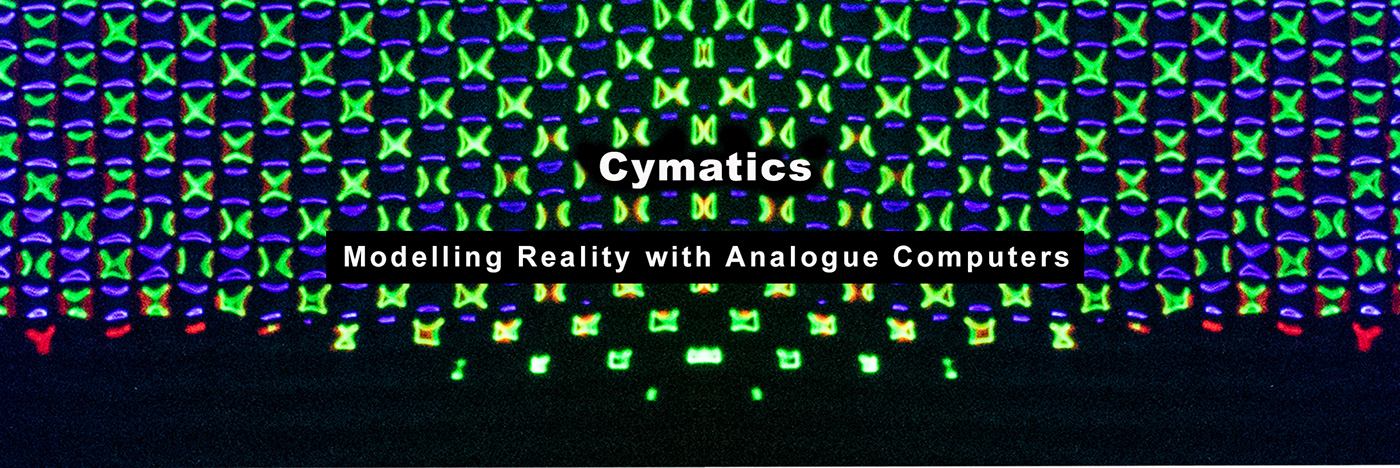

“The universe exists solely of waves of motion…There exists nothing other than vibration…In the wave lies the secret of creation” - Walter Russell
“You are a function of what the whole universe is doing in the same way that a wave is a function of what the whole ocean is doing... The ocean waves and the universe peoples”
- Alan Watts
Listen to this article instead. Note, the captions below each video and image are not included in this narration.
Research conducted by Andrew McGibbon, with assistance from Jarrod Akal.
At the bridge of sound and light we encounter the most incredible phenomenon, the emergence of form in the interference patterns of waves. Welcome to the wonderful world of cymatics.
In late 2019 I came across online videos of perfect geometry emerging from wave interference and couldn't quite believe what I was seeing. My initial assumption was that these images weren’t natural, that they had to have been rendered digitally. Following my curiosity, I decided to conduct some experimentation of my own to find out if I could achieve similar results. Lockdown 2020 provided the perfect opportunity to delve into the testing process with the requisite focus and attention. What transpired exceeded my expectations.
Cymatics is a developing science first practised by Hans Jenny in the 1950s, which is gaining in popularity among technical and enquiring minds. The instrument used is known as a cymascope (I am using this term to refer to any generic instrument used to view cymatics. Not to be confused with the brand name CYMASCOPE), which consists of a speaker, a small tank to contain liquid (attached to the speaker), a light source and a camera on the same or opposing axis as the light. As a hertz rate originating from the speaker is induced in the liquid by way of vertical oscillations, ripples begin emanating to the outer walls of the container and subsequently rebound inwards. The continuous frequency generates persistent ripples which interfere with the existing pattern. What can be observed is the emergence of perfect geometric form represented in standing waves that are made visible by the reflecting light. These standing waves are known as Faraday waves.
In this video, geometry emerges from the interference patterns of waves. The scene begins with a circular void surrounded by a ring of light, with small splatters of white paint at the bottom of the ripple tank to enhance the visibility of wave phenomena and their ability to bend and distort light. As the Hz rate is introduced, concentric circles form, reminiscent of the ripples created when a pebble is dropped into a pond. As the circles continue to expand and interact, they begin to interfere with one another, giving rise to geometric patterns.
It is early 2020 and I don’t have the necessary equipment to construct an authentic cymascope on hand, so I decide to improvise. I proceed to duct tape a cake tin lid to a subwoofer, add water, shine a torch at it, push play on the tone generator, hit record on my phone camera and hold thumbs. Almost instantly, I witness recognisable English letters and Western numerals among other foreign characters appearing in what I was later to term the 'ripple tank'. I hadn’t yet replicated the geometry I had seen online, but the realisation that there was something profound taking place began to dawn on me. I have since become convinced that this apparatus functions as an analog computer of sorts, capable of modelling reality, and the underlying process or mechanics could be conceptualised as a type of creation technology.
I decided to post a clip on twitter and gathered my first sample of the appetite there was for this kind of content. Energised and inspired I set about building a more precise instrument.
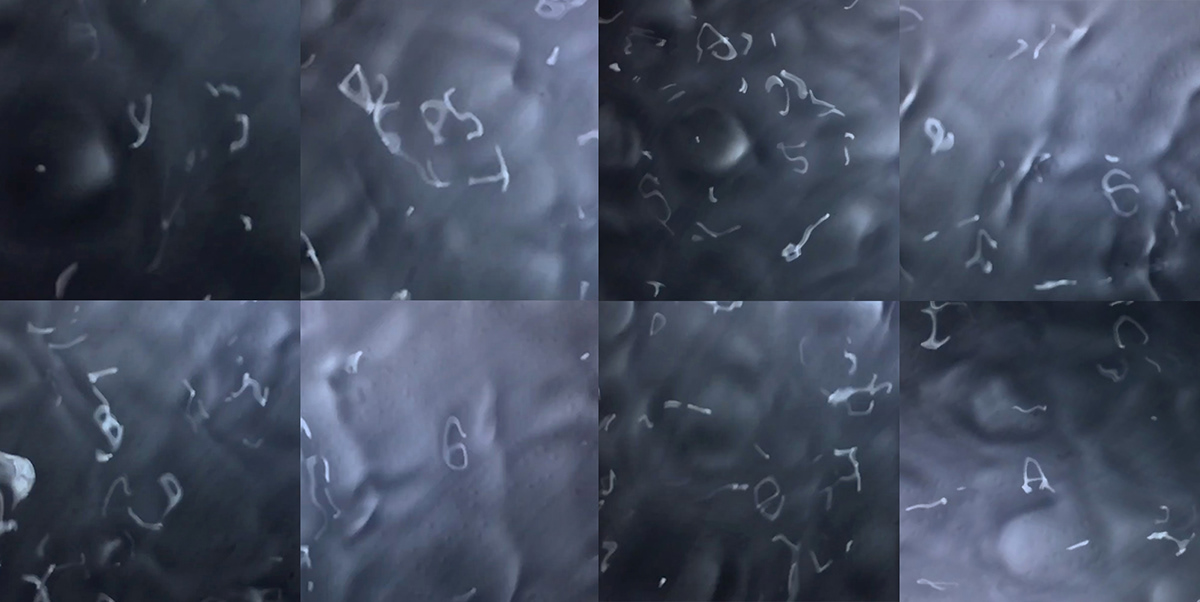
Here we see still images from my very first cymatics experiment, venturing into the world of waveforms by taping a cake tin lid to a subwoofer. The results were nothing short of fascinating, as clear English letters and numerals emerged from the chaotic dance of vibrations. Witness the birth of my exploration into cymatics, where the seemingly random oscillations revealed a hidden order and a possible connection to the language we use every day.
Over a period of a few months I had built my first high-performing scope and was creating various cymatic phenomena. Through trial and error I established the correct variables required to produce not only the lettering and numbers, but the very same geometric shapes I had originally viewed online, as well as other novel results. Adjustments to input variables (hertz rate, liquid volume etc.) produced a range of different outcomes in the ripple tank, which would include crystal lattices, ancient symbols and numerous symmetrical glyphs.
I learned about cavitation bubbles and how they can be generated in vodka by way of a sonic field. It amazed me to see the bubbles move around freely in a closed loop, sustained by the continued presence of the sonic field. I was left in awe of this scientific phenomenon, reminded of the exquisite natural beauty that exists in our world and the endless potential for discovery and innovation.
A captivating spectacle unfolds before us here. Our gaze is fixed upon a vessel of fluid that is intimately connected to a speaker. As sound waves are induced and their potency amplified, the fluid begins to oscillate and form bubbles. Then, as the amplitude is gradually decreased, a cohesive sonic field emerges in the form of a lattice. The bubbles, now consistently sustained by the energy of the wave field, move around freely within the closed-system.
I began to ponder the implications of this research, and the elegance with which the mechanism operates and can be understood. It occurred to me that this science could present an explanation for all the myriad expressions of form in the universe. What's even more curious is that it offers an alternative understanding of the alphabet which turns the conventional view on its head.
Upon sharing the work online I was encouraged by responses from various people confirming their recognition of letters in their native language. In particular a follower from Sweden felt certain they could identify Nordic runes. “It’s light language!” one enthusiastically proposed. Another dubbed it 'angel language'.
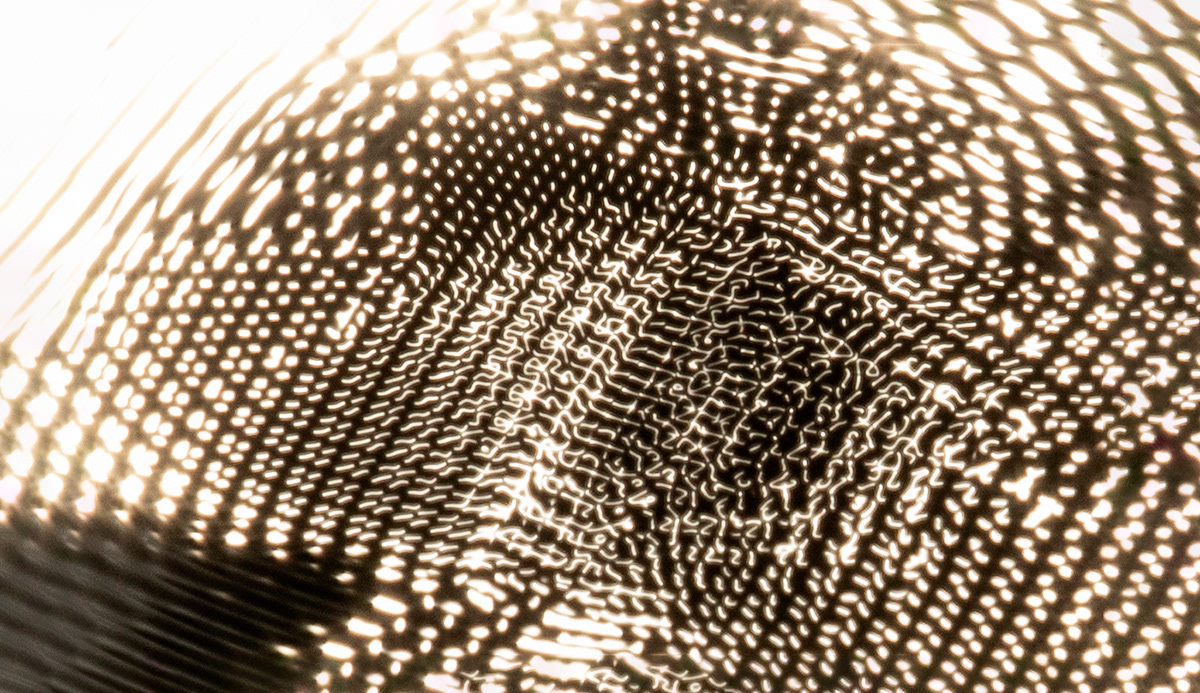
In this still image from a vodka and sunlight experiment, the light of the sun comes from an opposing angle, revealing a fascinating display of patterns. The central left portion of the image features shapes reminiscent of ancient Sanskrit, while on the right, when viewed with a tilted head, one can discern English letters 'A' and 'e'.
I want to bring to your attention the manner in which The Bible's Genesis chapter one portrays God's creative work as an act of speech, which is essentially vibratory in nature. This leads me to contemplate whether that ‘divine speech’ is not a singular cosmogonic event from the distant theological past, but rather an ongoing process that sustains all form in existence through time and space. The notion is not without precedence, as according to adherents of Kabbalah, a form of Jewish mysticism, God created the universe through the manipulation of the Hebrew alphabet and numerical system.
Furthermore, the biblical account of creation contains striking parallels with cymatics, where the earth is described as ‘formless and empty’, shrouded in darkness with the Spirit of God hovering over the waters (much like our ripple tank before the oscillations begin). Through divine speech, light is then separated from darkness, akin to the waves and emerging patterns in cymatics.
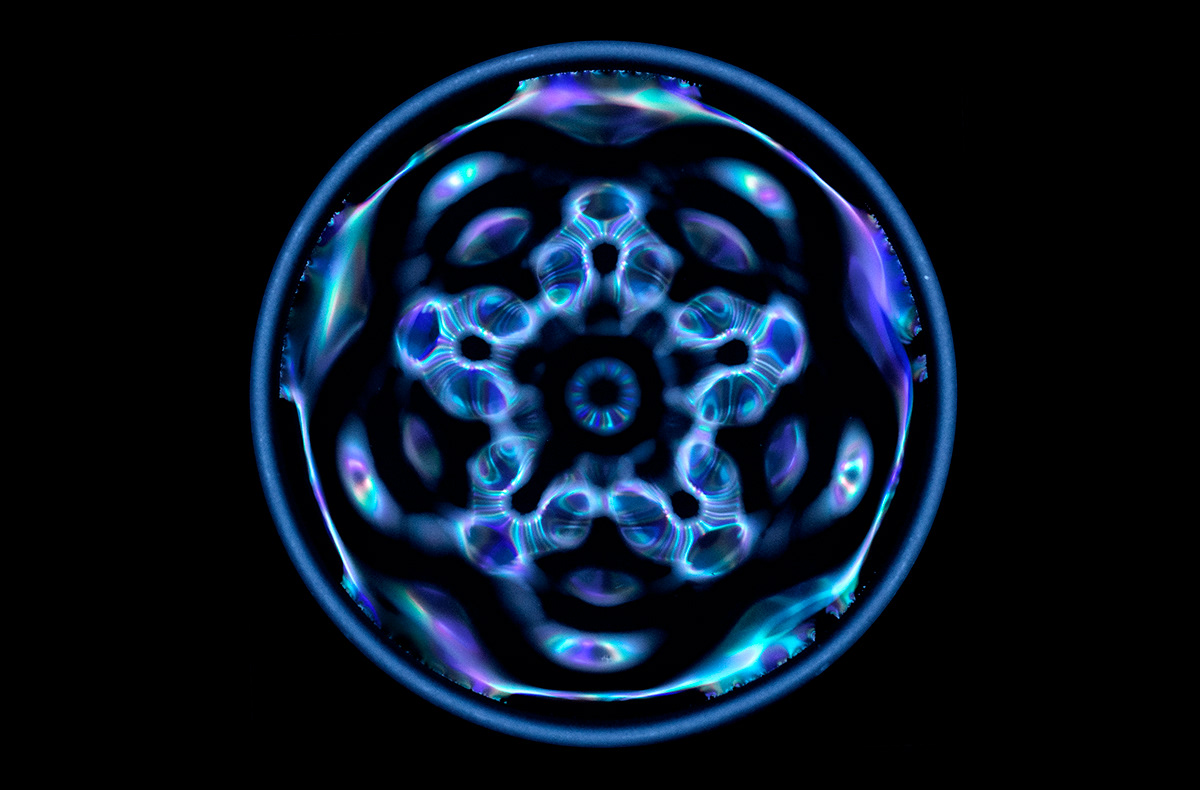
In this still image, we are presented with a remarkable display of perfect geometry that closely resembles a snowflake. The Faraday waves in the scene are beautifully illuminated by a vibrant combination of blue, purple, and green light, adding a touch to the overall visual.
Sound being represented as a basic sine wave should prompt us to consider the wave-like nature of our reality. The peak and trough interaction of waves can be extended to various other relationships such as light and dark, hot and cold, up and down etc. These represent inseparable, seemingly opposing aspects of the same fundamental phenomena, which differ only by degree. Something is only considered hard because whatever you measure it against is generally ‘softer’, and as such it’s a relationship of relativity. Duality is thus an inherent feature of our existence, where one aspect cannot exist without the other. This profound realisation allows us to delve deeper into the mysteries of our universe and gain a better metaphysical understanding of ourselves and the world around us.
In this video we start with a highly reflective sphere of liquid mercury, the vibrations initiate a transformation, as a pulsating five-sided shape emerges. It appears to be the very essence, or blueprint, of a flower.
My primary assertion is that vibration creates waves, and from the complex interplay of these waves, form emerges. Therefore, we can infer that all perceivable form in the universe, ranging from the latticing of molecules to the intricate symmetries of flowers, and even the counter-rotating fields that determine the distribution of pinecone and sunflower seeds, stem from a distinct vibration unique to each object or subject. In essence, this notion implies that every entity or object in existence is imbued with a unique vibration, which acts as a blueprint for its form and sustenance.
Additionally, it emphasises the interconnectedness of all things and illuminates the underlying vibratory nature of reality, revealing a harmony that exists beyond the apparent chaos of the world. Hans Jenny arrived at a similar conclusion and posited that ‘everything owes its existence solely and completely to sound, which holds it together and is the basis of form.’
In this sunlight and vodka experiment, we start with a simple setup: a small speaker with a dish attached to it, filled with liquid. The tank reflects sunlight coming from the opposite angle across the dish. As the vibrations begin, we initially see some imbalance. However, around the 17-second mark, we discover cohesion developing in the form of light dots scattered across the backdrop of the void. As the frequency is adjusted, a variety of patterns emerge, including, right at the end, the familiar counter-rotating field pattern.
By performing these experiments I not only confirmed the claims and findings of other researchers, but I would also elicit some novel results. For example when employing chilled vodka and a hertz rate of between 300 and 800 hz, two dimensional crystal lattice structures would emerge. In another instance using chilled vodka, imploding cavitation bubbles emitting symmetrical micro-jets could be seen. My most astonishing observation however came from my experimenting with a liquid mercury solution, which unexpectedly revealed the emergence of the Star of David, an ancient symbol demonstrated to be a product of wave interference.
In this experiment, the container used is an unconventional choice—a ceramic sewing thimble. We peer directly down into it, focusing on a tiny, approximately 1cm x 1cm droplet of liquid mercury at the bottom. As the Hz rate is introduced, we witness a transformation as the iconic Star of David emerges before our eyes. This final six-sided shape is composed of two distinct oscillation phases—an upward triangle, followed by a downward triangle.
In this video, we start with a perfectly still ripple tank, illuminated by a blend of red, green, and blue light. As a Hertz rate of 432 Hz is introduced, an intricate crystal lattice materialises. This pattern not only displays a sophisticated structure but also exhibits a subtle three-dimensional effect, giving the appearance of tapering off towards the edges, much like the stepped profile of an ancient Ziggurat.
This should perhaps go without saying, but it may be necessary at this juncture to draw a clear distinction between claims that can be substantiated with empirical evidence and those which occupy the realm of speculation, both of which are at play here. I do not intend to reduce speculative endeavour to something trivial by making this distinction, on the contrary I believe speculation can provide fuel for enquiry. However for the purpose of accuracy, credibility and in the interest of avoiding the moniker of pseudoscience, this distinction should be thoroughly considered by the reader. With that said, I was recently granted a poetic licence from a committee of machine elves residing in hyperspace and would be remiss to neglect it.
This demonstration showcases the emergence of symmetry from persistent and contained waves. The resulting patterns reveal the beauty and order that can arise from the dynamic interplay of energy, frequency, and spatial constraints.
At some point I decided I wanted to present my findings, the results of the experiments and some accompanying musings. I would need some assistance with the research and writing aspects of the project. An old colleague expressed interest in the role and so he joined me down the proverbial rabbit hole.
The twitter comment about Nordic Runes had lingered in the back of my mind. The prospect that certain characters which had emerged might closely resemble letters from an older, potentially ancient alphabet was enticing. Had I pierced the veil? Ventured through the looking glass? Tapped into something truly fundamental? An investigation into the origin and evolution of the alphabet would have to ensue.
In this compilation video, we observe the same scene illuminated by different coloured LED lights. This display serves as a prime example of the lettering phenomenon found in cymatics, and viewers are encouraged to frequently pause the high-definition video to examine the intricate details for themselves.
As it turns out, writing is a rather recent invention in human history, generally considered to have developed around 5000 years ago. For thousands of years before that, history was mostly handed down by oral tradition. The development of the alphabet is an intriguing subject, however for our purposes unnecessary to explore in detail. It suffices to say that nearly all alphabetic scripts used throughout the world today ultimately trace back to a Semitic proto-alphabet, the origins of which are located in ancient Egypt.
The conventional view, although not unanimous, is that this alphabet known as proto-sinaitic script, which has not been fully deciphered, was intended by its creators to repurpose hieroglyphics for their own language. The earliest fully deciphered alphabets include Egyptian Hieratic and Demotic, followed later by Phoenician and Ancient Hebrew among many others.
While analysing these alphabets, the focus was not only on the shape of the characters but also the style or font. Soft versus hard edges, sharpness, roundness, the width of the lines and so on. We searched for the closest character matches to the foreign symbols I had observed in my experiments. Similarities were certainly apparent, especially to the Hieratic script.
From the start, I resolved to accept the possibility that these foreign images I had witnessed were analogous to letters, but that was all. A direct link existed only in my imagination and the real world explanation was to be found at the doorstep of random coincidence. There was something about the significance of these letters that I couldn’t shake though, and after an epiphany I had while viewing a Norse mythology documentary I was spurred on along this particular course of inquiry by one of its central figures, that figure being the Norse God of War.
In this unconventional cymatics experiment, a simple bottle cap serves as the ripple tank, producing lettering as the vibrational patterns emerge. Viewers are encouraged to pause the video periodically to observe and try to recognise the various symbols that appear. This display demonstrates the remarkable ability of sound waves to interact with matter, creating complex and unexpected patterns even in the most modest of environments.
Are you aware that within the myth of Odin lies an allegorical cymatics experiment. Sceptical? Well allow me to wax poetic, just give me a minute while I engage my speculative goggles and machine elf licence disc.
The myth of Odin discovering the runes is, I would assert, an allegory for cymatics. Each element of the cymascope is present in the narrative subtext. Firstly we can identify a single axis line straight above a contained body of water. In this case it is Odin himself, hanging upside down so he is positioned looking directly at the water. It goes on to describe how he gouges out one of his eyes, which is pertinent as a cymascope requires a monocular scope. If one were to look at a vibratory pattern on a ripple tank with both eyes, there would be a parallax error.
To elaborate, the observation of standing wave patterns relies as much on the observer and their relative perspective as it does the wave interference itself. The third variable, (not specifically referred to in the myth), being light, which reflects off the peaks of the waves, rendering the constructive interference visible while the destructive interference seemingly remains a part of the void.
Odin then pierces his side so as to let a constant drip of blood fall into the water below, creating ripples. Are you starting to find this theory less far-fetched than you may have at first? Blink once for yes and twice for no. Make sure to blink with one eye only, I can't stress this detail enough. (I guess that's more of a wink than a blink but I digress). Finally, Odin is left hanging for nine days as the ripples accumulate and create interference patterns, eventually revealing the runes.
All of these variables are fundamental to a cymascope's functional process. To add a final layer of intrigue, as demonstrated, cymatics experiments can and do render lettering, some of which bear an uncanny resemblance to Nordic runes! As far as I know this interpretation of the Odin myth is entirely novel, and for this achievement I was congratulated with bouncing high fives from a party of etheric jesters doing Joe Rogan impressions, who had momentarily entered this dimension. Some experiences money can't buy.

In this side-by-side comparison, we observe a connection between mythology and cymatics. On the left, we see a depiction of Odin, the Norse god, hanging from the Tree of Life, Yggdrasil, above the waters of life. On the right, we find a diagram illustrating the process of cymatics.
What does this all mean? Could such symbols be artefacts from the unified field, the primordial ooze, the cosmo-cymatic soup if you will? That is to say, a repository of information and wave potential that can differentiate into infinite variations of form depending on the corresponding sound, frequency or vibration. In Theosophy and Anthroposophy we find mention of the Akashic records, which is a similar concept representing a compendium of universal information.
Is it possible that ancient civilisations may have accessed these symbols in a more basic way? Or perhaps in a more sophisticated way depending on whether you view history conventionally or through a mystery school lens. Maybe, just maybe, alphabets did not originate as a repurposed form of hieroglyphics but rather as emergent characters discovered via wave phenomena.
In this demonstration, we witness the emergence of a pentagram within a droplet of water. The droplets, varying in size, are placed on an oiled vibratory plate. The largest droplet, in particular, reveals an intricate 5-fold symmetry resembling the very essence of a blooming flower. This display highlights the underlying geometric patterns and connections that exist within nature, as well as the power of vibrations and frequencies to bring forth these forms.
The word magic elicits various responses depending on one’s worldview. Some may consider it primitive and associate it with make believe and superstition, others may not be so dismissive but would nonetheless define it as paranormal. Then there is the Arthur C. Clarke school of thought that suggests magic is just science we don’t understand yet.
In this demonstration, the light source used is none other than the sun itself, streaming through a window at an angle. The camera is strategically placed on the other side of the ripple tank, creating an opposing angle. As the liquid (vodka) inside the tank is vibrated, the angled waveform generates a mesmerising display, appearing partly as individual lights dancing gracefully across a black background, and partly as a dynamic radio wave. The formation of the lights and their fluid motion evolve throughout the video as the Hz rate is "ridden" up and down.
There’s a common thread of alphabets being historically linked to magic. The research of Robert Sepehr reveals how the consonants of the Hebrew and Phoenician languages correlate to an ancient system of magic whereby letters are assigned a numeric value. This is an inherent part of Kabbalah and gematria as well as numerology, which was practised in all ancient empires from Assyria, Babylon, Greece, Egypt and likely even earlier. These alphabets were not based on random sounds, but rather on mathematics, as the language of the gods appears to be linked to numbers and sacred geometry.
According to Sepehr, the runes too were more than just a writing system, they were also used for purposes of magic. Evidence of this is documented in numerous non-linguistic inscriptions, carved on swords, staffs and other items used as a sigil. These links between letters, geometry, creation, magic and ultimately cymatics are quite compelling, wouldn’t you agree?
In this display, we bear witness to a phenomenon akin to that which we observed in the first video in this presentation. However, this time around, we introduce oil into the mix, which reveals a new aspect of the scene. As we watch, we perceive not only a symmetry in the interference patterns of the waves, but also a discernible flow that guides the movements of the water as it flows through the system.
It has been frequently hypothesised by scholars on the academic fringes that ancient civilisations may have possessed capabilities that would make our collective jaws drop and our tongues roll out in disbelief. The ability to cut and move massive blocks of stone and the geometric precision required to construct the Egyptian pyramids or other ancient megalithic structures such as Gobekli Tepe are difficult to explain using a framework of bronze age tools, pulley systems and beasts of burden. The utilisation of what could be described as a form of sound technology involving something akin to levitation, vibrational liquefaction and sonic cutting have been suggested as alternative theories.
As the saying goes, the truth is often stranger than fiction, and I would go even further to say that much of mainstream history is exactly that, a fiction. Ultimately, these questions lead us down a path of introspection and force us to question the nature of reality, our perception of the past, and the veracity of our beliefs. By engaging in such inquiry, we expose ourselves to new possibilities and expand our understanding of the universe.
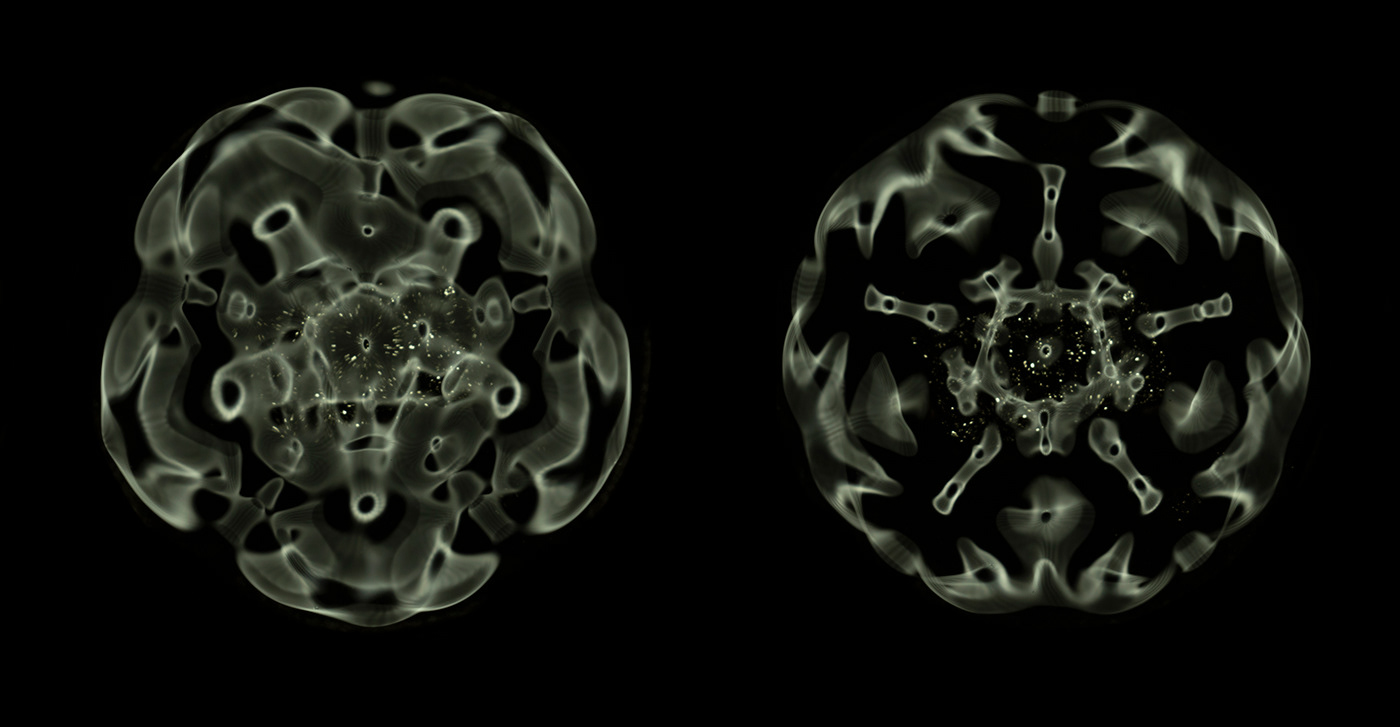
In this side-by-side, we are presented with two distinct cymaglyphs: one for each phase of oscillation. Remarkably, one phase takes the shape of the ancient Baphomet symbol, while the opposing phase forms a 5-sided star reminiscent of bone structure. The human form can also be perceived as a 5-sided star.
The presence of the Baphomet symbol and the human form in these oscillating cymaglyphs may have deeper implications, touching upon the concept of the Jungian shadow. Baphomet, often associated with occultism and mysticism, can be seen as a representation of the shadow side of humanity—the darker, hidden aspects of our psyche. Meanwhile, the human form, symbolised by the 5-sided star, embodies our conscious self and the aspects of our personality we are aware of and show to the world.
The oscillation between these two contrasting symbols in the cymaglyphs highlights the complex interplay between our conscious selves and our shadow selves, reminding us that both aspects are essential to understanding the complete human experience. The intricate patterns of these cymaglyphs not only display interesting geometric relationships but also offer insights into the human condition.
For some time now the scientific community has attempted to reconcile Albert Einstein's general theory of relativity with quantum mechanics. The cosmos is often portrayed as being divided into two scales: the very large, and the very small. The theory of relativity, it is said, adequately explains the workings of the very large scale and quantum mechanics the very small. However, what has been persistently sought after, not entirely unlike Indiana Jones pursuing the holy grail, is a unifying 'theory of everything'.
Theories that have auditioned for the part include string theory (in fact multiple different string theories), superstring theory (Lois Lane had a huge crush on this one) as well as M-theory. In addition to these is string cosmology, a relatively new field that tries to apply string theory equations to solving the questions of early cosmology.
Where am I going with this exactly? I'm glad you asked. You see, what lies at the heart of these complex theories starts with a 'vi' and ends with a 'bration'. Please adjust your seat to the upright position, we will be landing soon.
The theoretical framework of the previously mentioned theories involves the replacement of the point-like particles of particle physics with one dimensional vibrating strings. These strings propagate through space and interact with each other, their properties determined by the vibrational state of the string.
In this cymatics demonstration, liquid mercury is once again subjected to the influence of sound. A pentagonal structure emerges in response to the sonic vibrations. Beyond the primary standing waves, one can also observe a 'pulsing' phenomenon, as if waves of energy are coursing through the geometric pattern.
A major shortcoming with these theories however, is that they are supported by mathematics and little else. The strings said to exist are so tiny it's nearly impossible to experiment and check the validity of the theory itself, or the mathematics explained by it using current instrumentation. They are thus devoid of empirical evidence, and so the coveted theory of everything remains elusive.
By contrast, insights that can be garnered from cymatics are arrived at through direct observation of natural phenomena, and simple reproducible experiments that can be easily performed at home (go ahead, try it yourself). Nonetheless, I find it noteworthy and if I’m being honest somewhat titillating that all roads seem to lead to vibration. Ready? Okay! Give me a v! Give me an i! Give me a b!...
In this truly perplexing video, we witness a lattice field forming within a solvent (vodka) as it responds to sound vibrations. During the experiment, some bubbles are created when the amplitude is pushed to a high level. As the amplitude is subsequently reduced and eventually turned off, an intriguing phenomenon occurs: one of the bubbles seemingly 'devours' three others before imploding. This implosion sends out a series of micro-jets that are illuminated by the RGB light grid. The fleeting formation that emerges bears a striking resemblance to a hydrogen atom's d-orbital or even a structure created using 3D design software. Note: This video is slowed down
“The day science begins to study non-physical phenomena, it will make more progress in one decade than in all the previous centuries of its existence.” - Nikola Tesla.
A rather provocative statement isn't it? Well some provocation is warranted in my opinion, especially considering the target of Tesla's frustration either never received the memo or simply chose to ignore it. I echo this sentiment insofar as I believe that rigid scientific materialism to this day remains a hindrance to the advancement of knowledge and understanding.
Which brings me to the subject of fields. No, not fields of the football variety, or of the eternal psychedelic strawberry nature found in a John Lennon lyric. In physics a field is a physical quantity, represented by a vector, that has a value for each point in space and time. Magnetic and electrical fields are familiar examples.
In our context a field can be defined as a region of space in which wave interference occurs. Furthermore, the wave field is determined by the magnitude and direction of the waves at every point in space. When two or more waves meet in the same region, their interaction can result in constructive or destructive interference, depending on their relative phase and amplitude. This interference pattern can create areas of high and low intensity, which can be visualised as a standing wave pattern. Essentially, the field describes the distribution of energy carried by the waves and how they interact with each other in the region of space.
LOUD AUDIO WARNING (Turn down volume)
In this demonstration, the ripple tank is illuminated by a radiant golden light. As the Hz frequency is introduced, a crystal lattice materialises, forming an impressively cohesive square-shaped pattern. Much like other lattice structures observed in cymatics, this shape exhibits a three-dimensional appearance, with the edges seemingly "stepping down" towards the surrounding liquid, like a ziggurat.
Following from my primary assertion I contend that reality is not made up of particles, or rather anything that can be regarded as a ‘thing’ but of oscillating systems that create mental fields. These fields are emergent phenomena of wave interference that take on complex geometric forms. The geometric shapes of the mental fields are not arbitrary but arise from the interactions between the underlying systems. In addition, the mental fields not only contain information about the systems but also contribute to the overall structure of reality. As a result, the mental fields are closely linked to the underlying energy systems, designing and guiding the behaviour of the universe.
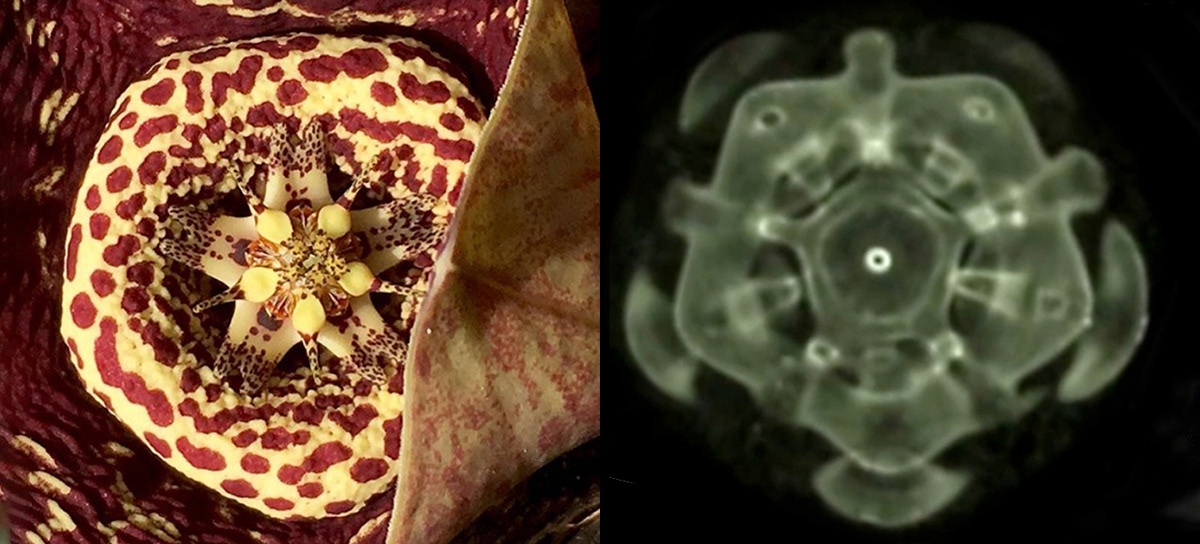
In this side-by-side comparison we have a cymaglyph, a term used to describe the intricate shapes that emerge in the waves of a ripple tank. On the right is a photograph of the Ceropegia mixta flower, grown and captured by the author. Both images exhibit multiple layers of geometry—a pentagram within a pentagon, within a pentagram, and so on. Additionally, another intriguing cymatics phenomenon becomes apparent: the patterns observed on the leaves and other parts of the flower mirror the seemingly random arrangement of varying-sized 'dots' found in other cymaglyph examples.
Physical form fills the field. A compelling example of this is phantom limb syndrome, a condition in which patients experience sensations, whether painful or otherwise, in a limb that does not exist. This has been reported to occur in 80-100% of amputees. While in the phenomenon of newt limb regeneration, the newt generates at the stump a cell mass known as a blastema, from which a new functional limb is eventually grown.
Another pertinent example occurs in bar magnets where if the magnet is cut in half between the north and south poles, the two pieces form two separate magnets with new north and south poles formed at the edges. The field is always whole, it exists outside of the physical structure and dictates the form that is taken on. The academic establishment is uncertain about what is instructing form, they presume they will discover a mechanism in DNA, but as it's all conjecture currently, this is the most elegant postulate I can muster. Such a perspective suggests that the universe is a complex and interconnected system, fundamentally shaped by the mind.
In a 1916 essay titled 'The Structure of the Unconscious' pioneering psychologist Carl Jung first introduced the term 'collective unconscious'. Jung's thesis was that in addition to a personal unconscious, there exists a second psychic system of a collective, universal, and impersonal nature which is identical in all individuals. It consists of pre-existent symbols and patterns known as archetypes. Jung linked the collective unconscious to what eminent psychologist Sigmund Freud called 'archaic remnants' - mental forms whose presence cannot be explained by anything in the individual's own life and which seem to be aboriginal, innate, and inherited shapes of the human mind.
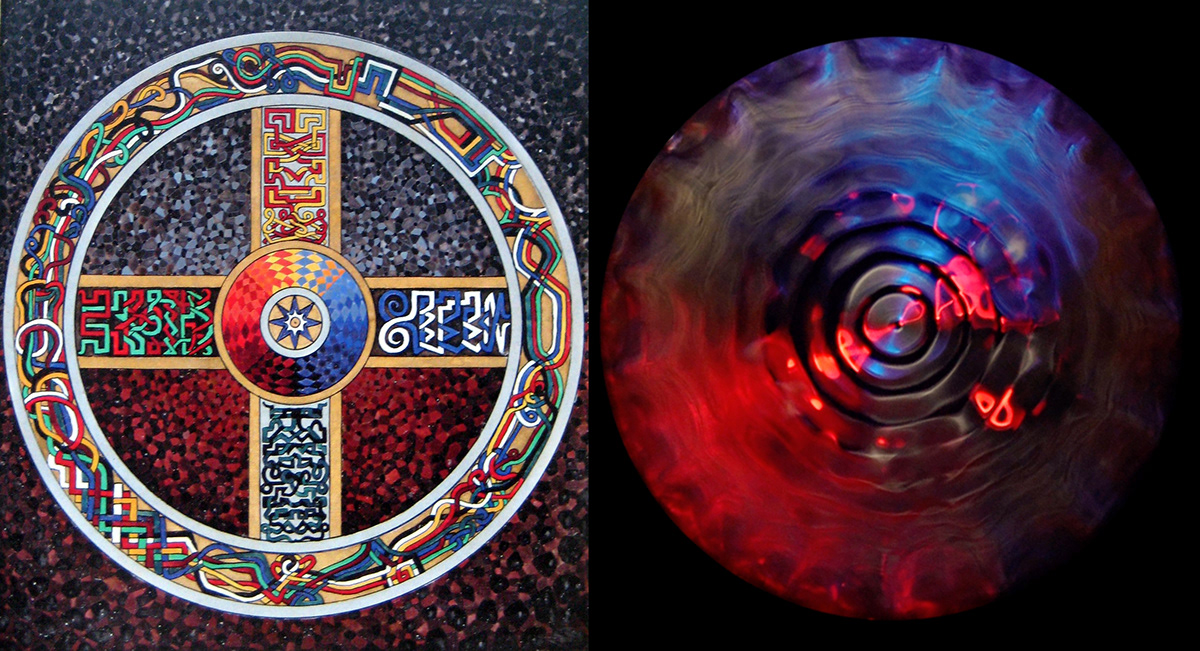
In this comparison, we see a resemblance between two distinct images. On the left is a still image of a cymaglyph showcasing the patterns and symmetries formed in liquid mercury through the process of cymatics. On the right is a mandala drawn by the renowned psychologist Carl Jung, who used these complex, circular designs as a tool for personal growth and self-exploration. The similarities between these two images hints toward a connection between the natural world's hidden order, as unveiled by cymatics, and the human psyche's intricate workings.
Fast forward to 1973 where scientist Rupert Sheldrake has a sudden insight, a radical idea which he spends years thinking about before publishing it in his first book 'A New Science of Life' in 1981. This radical idea is the theory of 'morphic resonance' which proposes a collective memory inherent in nature which each individual contributes to and draws from. It is a controversial alternative to the established view of stored memory traces inside our brains.
The theory explores how similar patterns of vibratory activity in self organising systems influence subsequent similar systems. Sheldrake explains that morphic resonance works on similarity, and describes it as a similarity selection system which bears resemblance to aspects of quantum theory like quantum entanglement. “I was interested in the concept of morphogenetic, or form-shaping fields, but realised they could not be inherited through genes. They had to be inherited in some other way”, argues Sheldrake.
The parallels between Jung and Sheldrake's aforementioned concepts are undeniable. Perhaps the archetypes of the collective unconscious, those universal symbols and patterns, are non-physical organising fields that fashion the development of life on earth, much in the same way as morphic fields? Which in turn inform the behaviour and habits of living systems, including individual organisms, groups of animals, and human societies. Examples of morphic fields in nature include formation patterns in flocks of birds and schools of fish.
A close-up of a lattice field made in single malt whisky...
I view these as two parts of the same phenomenon, organising fields from the greater to the lesser. Large fields governing things like galaxies down to solar systems and planets, then smaller and smaller fields of organisation, that govern
individuals for instance, through our physical form, habits and aspects of our personality.
A suitable analogy would be that of Russian nesting dolls, or alternatively fractals. Fields within fields that are all part of a unified whole. In the case of the universe - a single system of oscillating energy. From a wide angle perspective, broad patterns can be observed but as we zoom in we observe endless novelty in the patterning. So what we perceive as separate ‘things’ like a flower and a bee, or planet earth and a human, are not isolated but different connected parts of the same whole. To quote Viktor Schauberger, “everything is governed by one law, a human being is a microcosmos, the laws prevailing in the cosmos also operate in the minutest space of the human being”.
It’s apparent to me that there is a force at work here, however the point where labels are assigned to it is usually the same point where conflict or division occurs. I have no ideological agenda and would prefer to avoid that altogether. Words like source, God or divine intelligence have obvious religious and/or spiritual connotations with highly subjective interpretations. This tends to breed belief system squabbles and potentially alienate agnostics or atheists. Let’s give that a hard miss, a solid thanks but no thanks.
Instead, I will leverage my poetic licence (valid until 2030) a final time and refer to this force as the voice (relax literalists) of a design intelligence (see what I did there?), shaping the universe through its vibration and the interference of its waves. In this scenario, that voice is the source of all energy, the origin of all form, and the ultimate guiding power behind the development and evolution of life, as a single system of oscillating energy. The archetypes and morphic fields it generates serve as the means by which this voice speaks, weaving the fabric of existence and conducting the symphony of life on earth. So what came before the voice you might be wondering? Well that’s easy… American Idol.
I would submit that cymatics provides some evidence for this hypothesis, and perhaps, facilitates direct access to channels of the design (and if it suits you, divine) broadcast. So what are you waiting for? Tune in and vibe out.
In this final demonstration, liquid mercury is again used within a sewing thimble, but this time, the experiment employs both the RGB light grid and the circular white light simultaneously. It is as if one is peering through a mystical veil. The resulting glyph evokes images of a mandala meticulously drawn by Carl Jung, with intricate patterns and even what appear to be letters emerging from the waving display.


